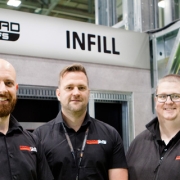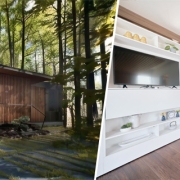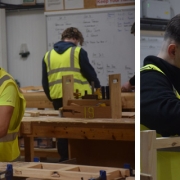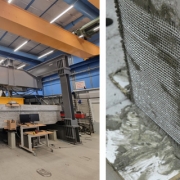M-AR Offsite has partnered with Biffa, the UK’s leading sustainable waste management company, to ensure all waste generated through its manufacturing and construction operations is reused or recycled.
Through the partnership M-AR is refreshing its current waste management programme with the aim of diverting 100 per cent of its waste from landfill. The new Biffa skips in place around M-AR’s factory have clear signage as well as being colour coded to help visually identify what waste goes in which skip. It also creates a clear central focal point for waste management in the factory, which along with M-AR’s newly appointed ‘Waste Champions’, is designed to maximise take-up among staff.
Tom Malcom and Jamie Leckenby, who are both part of M-AR’s internal logistics team, nominated themselves to be M-AR’s first ‘Waste Champions’. The role involves educating the team and communicating policy changes to the whole production team. They will both receive specialist training and support from Biffa to appreciate the benefits of segregating waste effectively.
M-AR has also invested in upgrading its internal bins, moving away from the plastic 1100ltr bins which can easily become damaged, to a more robust steel tipper skip. As well as being more durable and therefore safer, these will also vastly reduce the number of trips previously required to load onto fork lift trucks and dispose waste into larger skips.
Working in partnership like this will see Biffa and M-AR collaborate on future waste reduction initiatives to implement within the business. M-AR will also be able to accurately report on waste volumes and disposals to track ongoing progress and understand where changes may need to be made to the process through its own online Biffa portal. The signage boards placed around the factory, as well as acting as prominent reminders about segregation of waste materials, will be used to provide feedback to the factory from the data collated from the Biffa portal.
Dan Lowther, head of procurement and supply chain at M-AR said:
“While this first phase covers waste management specifically relating to our manufacturing facility in Hull, our ultimate aim is to roll the programme out to all our live construction sites across the UK. This step marks a significant improvement in the reduction of waste generated on construction sites which are typically harder to regulate than a controlled factory setting and will mean that we’re able to divert all waste material from landfill whether that’s generated in the factory or on site. Reducing our waste materials to zero is a key part of our ongoing commitment to achieving net zero status as a company and reducing the embedded carbon of the modules we manufacture and install.”
Shaun Williams from Biffa’s commercial team in Humberside, added:
“We know recycling and sustainable waste management is extremely important to companies of all sizes, so we’re delighted to be working with the team at M-AR to bring our knowledge and skills to drive sustainability at their factory.
“Small steps can make a big difference, and recycling more waste means there’s less consumption of raw materials and fewer carbon emissions, which all contributes to the UK’s effort to achieve net zero.”
For more information call 01482 635 081
CLICK HERE to email M-AR
OR HERE to visit the M-AR website















